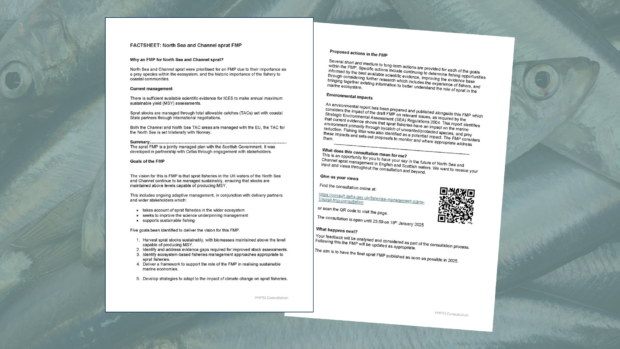https://defrafmp.blog.gov.uk/factsheet-north-sea-and-channel-sprat-fisheries-management-plan-fmp/
FACTSHEET: North Sea and Channel sprat Fisheries Management Plan (FMP)
Why an FMP for North Sea and Channel sprat?
North Sea and Channel sprat were prioritised for an FMP due to their importance as a prey species within the ecosystem, and the historic importance of the fishery to coastal communities.
Current management
There is sufficient available scientific evidence for ICES to make annual maximum sustainable yield (MSY) assessments.
Sprat stocks are managed through total allowable catches (TACs) set with coastal State partners through international negotiations.
Both the Channel and North Sea TAC areas are managed with the EU, the TAC for the North Sea is set trilaterally with Norway.
Summary
The sprat FMP is a jointly managed plan with the Scottish Government. It was developed in partnership with Cefas through engagement with stakeholders.
Goals of the FMP
The vision for this is FMP is that sprat fisheries in the UK waters of the North Sea and Channel continue to be managed sustainably, ensuring that stocks are maintained above levels capable of producing MSY.
This includes ongoing adaptive management, in conjunction with delivery partners and wider stakeholders which:
- takes account of sprat fisheries in the wider ecosystem
- seeks to improve the science underpinning management
- supports sustainable fishing
Five goals been identified to deliver the vision for this FMP.
- Harvest sprat stocks sustainably, with biomasses maintained above the level capable of producing MSY.
- Identify and address evidence gaps required for improved stock assessments.
- Identify ecosystem-based fisheries management approaches appropriate to sprat fisheries.
- Deliver a framework to support the role of the FMP in realising sustainable marine economies.
- Develop strategies to adapt to the impact of climate change on sprat fisheries.
Proposed actions in the FMP
Several short and medium to long-term actions are provided for each of the goals within the FMP. Specific actions include continuing to determine fishing opportunities informed by the best available scientific evidence, improving the evidence base through considering further research which includes the experience of fishers, and bringing together existing information to better understand the role of sprat in the marine ecosystem.
Environmental impacts
An environmental report has been prepared and published alongside this FMP which considers the impact of the draft FMP on relevant issues, as required by the Strategic Environmental Assessment (SEA) Regulations 2004. This report identifies that current evidence shows that sprat fisheries have an impact on the marine environment primarily through bycatch of unwanted/protected species, and prey reduction. Fishing litter was also identified as a potential impact. The FMP considers these impacts and sets out proposals to monitor and where appropriate address them.
What does this consultation mean for me?
This is an opportunity for you to have your say in the future of North Sea and Channel sprat management in English and Scottish waters. We want to receive your input and views throughout the consultation and beyond.
Give us your views
Find the consultation online at: https://consult.defra.gov.uk/fisheries-management-plans-1/sprat-fmp-consultation
The consultation is open until 23:59 on 19 January 2025.
What happens next?
Your feedback will be analysed and considered as part of the consultation process. Following this the FMP will be updated.
The aim is to have the final sprat FMP published as soon as possible in 2025.
For a printable version of this factsheet please contact FMPs@defra.gov.uk
